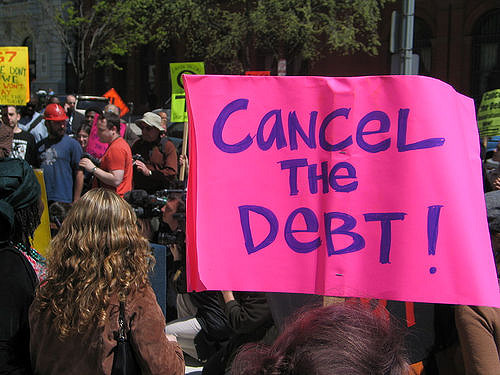A World Deep in Debt…

Debt, debt, debt…?debt is kind of like a snowflakes. ?A single snowflake is a pretty star, but one quintillion of them is a horrendous mess. ?In the same way, most individual debts are reasonable and justifiable, but when debt becomes a pervasive part of the economic system, the second order effects kick in:
- As fixed claims grow relative to equity claims, the economy becomes less flexible, because many are counting on the debts for which they are creditors to be paid back at par.
- Economies that are heavily indebted grow slower.
- Central banks following untested and dubious theories like QE and negative interests rates try help matters, but end up making things worse. ?(Gold would be an improvement. ?Just regulate the solvency of banks tightly, which was not?done in cases where?the gold standard failed.)
- Political unrest leads to dubious populism, and demands for debt cancellation, and a variety of other quack economic cures.
- The most solvent governments find high demand for their long debt. ?Long-dated claims raise in value as inflation falls along with monetary velocity.
Thus the mess. ?Bloomberg had an article on the topic recently, where it tried to ask whether and where there might be a crisis. ?I’ve argued in the last year that we shouldn’t have a major crisis in the US over domestic debts. ?There are a few areas that look bad:
- Student loans
- Agriculture loans
- Corporate debts to speculative grade companies that are negatively affected by falling crude oil and commodity prices.
- Maybe some auto loans?
But those don’t add up to a debt market in trouble as when residential mortgages were on the rocks.
But what of other nations and their debts, public and private?
Tough question.
That said, the answer is akin to that for a corporation with a tweak or two. ?It’s not the total amount of indebtedness versus assets or income that is the main issue, it is whether the debts can continue to be rolled over or not. ?A smaller amount of debt can be a much larger problem than a bigger amount that is longer. (point 2 below)
Take a step back. ?With countries there are a variety of factors that would make skeptical about their financial health:
- Large increases in indebtedness
- Large amounts of short-term debt
- Large amounts of foreign currency-denominated liabilities (also true of the entire Eurozone — you don’t control the value of what you will pay back)
- A fixed, or pseudo-fixed exchange rate (versus floating)
- A weak economy, and
- Debt and/or debt service to GDP ratios are high
The first point is important because whatever class of debt increases the most rapidly is usually the best candidate for credit troubles. ?Debt that is issued rapidly rarely gets put to good uses, and those that buy it usually aren’t doing their homework.
Under ordinary circumstances, this would implicate China, but the Chinese government probably has enough resources to cover their next credit crisis. ?That won’t be true forever, though, and China needs to take steps to make their banking system sound, such that it never generates losses that an individual bank can’t handle. ?Personally, I doubt that it will get there, because members of the Party use the banking system for their own benefit.
Points 3, 4, and 6 deal with borrowers compromising on terms in order to borrow. ?They are stretching, and accepting?terms not adjustable in favor of the debtor, or can be adjusted against the debtor. ? If you control your own currency, these problems are modified, because of the option to print currency to pay off debt, and inflate problems away. (Which creates other problems…)
By pseudo-fixed interest rates, I take into account countries that as neo-mercantilists make policy to benefit their exporters at the cost of their importers and consumers. ?These countries fight changes in the exchange rate, even though the exchange rate may technically float.
Point 5 simply says that there is insufficient growth to absorb the increases in debt. ?Economies growing strongly rarely default.
Conclusion?
My view is this: the next major credit crisis will be an international one, and will involve governments that can’t pay on their debts. ?It won’t include the US, the UK, and certainly not Canada. ?It probably won’t involve China. ?Weak parts of the Eurozone and Japan are possibilities, along with a number of emerging markets.
And, as an aside, if?this happens, people will lose faith in central banks as being able to control everything. ?I think the central banks and national treasuries will find themselves hard pressed to find agreement at that time. ?QE and negative interest rates might be controllable in a domestic setting, but in an international framework, other nations might finally say, “Why would I want to get paid back in that weak currency?” ?(And what holds that back now is that virtually all of the world’s currencies except gold are involved in competitive devaluation to some extent.)
My advice is this: be careful with your international holdings. ?The world may be peaceful right now, and everyone may be getting along, but that might not last. ?Diversification is a good idea, but don’t forget that there is no place like home, unless the crisis is in your home.





